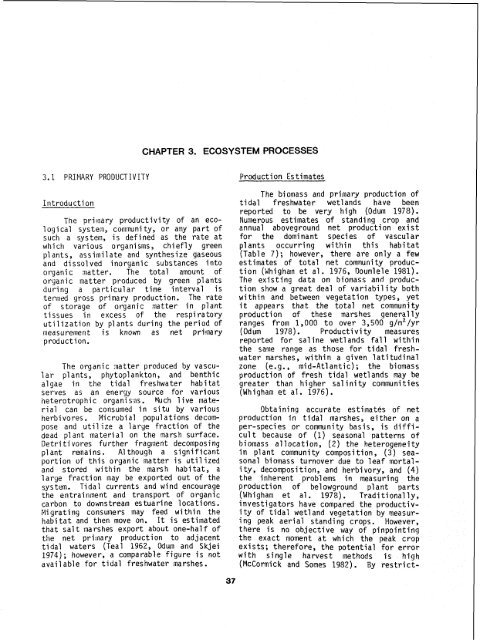The Ecology of Tidal Freshwater Marshes of the - USGS National ...
The Ecology of Tidal Freshwater Marshes of the - USGS National ...
The Ecology of Tidal Freshwater Marshes of the - USGS National ...
Create successful ePaper yourself
Turn your PDF publications into a flip-book with our unique Google optimized e-Paper software.
CHAPTER 3. ECOSYSTEM PROCESSES3.1 PRIMARY PRODUCTIVITYIntroduction<strong>The</strong> primary productivity <strong>of</strong> an ecologicalsysteln, community, or any part <strong>of</strong>such a system, is defined as <strong>the</strong> rate atwhich various organisms, chiefly greenpl ants, assimilate and syn<strong>the</strong>size gaseousand dissolved inorganic substances intoorganic inatter. <strong>The</strong> total amount <strong>of</strong>organic matter produced by green plantsduring a particular time interval istermed gross primary production. <strong>The</strong> rate<strong>of</strong> storage <strong>of</strong> organic matter in planttissues in excess <strong>of</strong> <strong>the</strong> respi raioryutilization by plants during <strong>the</strong> period <strong>of</strong>measurenlent is known as net pri!naryproduction.<strong>The</strong> organic satter produced by vascularplants, phytoplankton, and benthicalgae in <strong>the</strong> tidal freshwater habitatserves as an energy source for variousheterotrophic organi s-as. Much 1 ive materialcan be consumed in situ by variousherbivores. Microbial populations decomposeand utilize a large fraction <strong>of</strong> <strong>the</strong>dead plant material on <strong>the</strong> marsh surface.Detritivores fur<strong>the</strong>r fragment decomposingplant remains. A1 though a significantportion <strong>of</strong> this organic matter is utilizedand stored within <strong>the</strong> marsh habitat, alarge fraction may be exported out <strong>of</strong> <strong>the</strong>system. <strong>Tidal</strong> currents and wind encourage<strong>the</strong> entrainment and transport <strong>of</strong> organiccarbon to downstream estuarine locations.Migrating consumers may feed within <strong>the</strong>habitat and <strong>the</strong>n move on. It is estimatedthat salt marshes export about one-ha1 f <strong>of</strong><strong>the</strong> net pritnary production to adjacenttidal waters (Teal 1962, Odum and Skjei1974) ; however, a comparable figure is notavail able for tidal freshwater marshes.Production Estimates<strong>The</strong> biomass and primary production <strong>of</strong>tidal freshwater wetlands have beenreported to be very high (Odum 1978).Numerous estimates <strong>of</strong> standing crop andannual aboveground net production existfor <strong>the</strong> dominant species <strong>of</strong> vascularplants occurring within this habitat(Table 7); however, <strong>the</strong>re are only a fewestimates <strong>of</strong> total net communi ty production(Whigham et al. 1976, Dournlele 1981).<strong>The</strong> existing data on biomass and productionshow a great deal <strong>of</strong> variability bothwithin and between vegetation types, yetit appears that <strong>the</strong> total net communityproduction <strong>of</strong> <strong>the</strong>se marshes generallyranges from 1,000 to over 3,500 g/m2/yr(Odum 1978). Productivity measuresreported for saline wetlands fall within<strong>the</strong> saoie range as those for tidal freshwatermarshes, within a given latitudinalzone (e.g., mid-At1 antic) ; <strong>the</strong> biomassproduction <strong>of</strong> fresh tidal wetlands may begreater than higher sal ini ty communities(Whigham et al. 1976).Obtaining accurate estimates <strong>of</strong> netproduction in tidal marshes, ei<strong>the</strong>r on aper-species or community basis, is difficultbecause <strong>of</strong> (1) seasonal patterns <strong>of</strong>biomass allocation, (2) <strong>the</strong> heterogeneityin plant community composition, (3) seasonalbiomass turnover due to leaf mortality,decomposition, and herbivory, and (4)<strong>the</strong> inherent problems in measuring <strong>the</strong>production <strong>of</strong> belowground plant parts(Whigham et a1 . 1978). Traditionally,investigators have compared <strong>the</strong> productivity<strong>of</strong> tidal wetland vegetation by measuringpeak aerial standing crops. However,<strong>the</strong>re is no objective way <strong>of</strong> pinpointing<strong>the</strong> exact moment at which <strong>the</strong> peak cropexists; <strong>the</strong>refore, <strong>the</strong> potential for errorwith single harvest methods is high(McCormick and Somes 1982). By restrict-

















